Cross-Media Hash Retrieval Using Multi-head Attention Network
Zhixin Li,
Feng Ling,
Chuansheng Xu,
Canlong Zhang,
Huifang Ma

Auto-TLDR; Unsupervised Cross-Media Hash Retrieval Using Multi-Head Attention Network
Similar papers
Discrete Semantic Matrix Factorization Hashing for Cross-Modal Retrieval
Jianyang Qin, Lunke Fei, Shaohua Teng, Wei Zhang, Genping Zhao, Haoliang Yuan

Auto-TLDR; Discrete Semantic Matrix Factorization Hashing for Cross-Modal Retrieval
Abstract Slides Poster Similar
Fast Discrete Cross-Modal Hashing Based on Label Relaxation and Matrix Factorization
Donglin Zhang, Xiaojun Wu, Zhen Liu, Jun Yu, Josef Kittler

Auto-TLDR; LRMF: Label Relaxation and Discrete Matrix Factorization for Cross-Modal Retrieval
VSB^2-Net: Visual-Semantic Bi-Branch Network for Zero-Shot Hashing
Xin Li, Xiangfeng Wang, Bo Jin, Wenjie Zhang, Jun Wang, Hongyuan Zha

Auto-TLDR; VSB^2-Net: inductive zero-shot hashing for image retrieval
Abstract Slides Poster Similar
Hierarchical Deep Hashing for Fast Large Scale Image Retrieval
Yongfei Zhang, Cheng Peng, Zhang Jingtao, Xianglong Liu, Shiliang Pu, Changhuai Chen

Auto-TLDR; Hierarchical indexed deep hashing for fast large scale image retrieval
Abstract Slides Poster Similar
Object Classification of Remote Sensing Images Based on Optimized Projection Supervised Discrete Hashing
Qianqian Zhang, Yazhou Liu, Quansen Sun

Auto-TLDR; Optimized Projection Supervised Discrete Hashing for Large-Scale Remote Sensing Image Object Classification
Abstract Slides Poster Similar
DFH-GAN: A Deep Face Hashing with Generative Adversarial Network
Bo Xiao, Lanxiang Zhou, Yifei Wang, Qiangfang Xu

Auto-TLDR; Deep Face Hashing with GAN for Face Image Retrieval
Abstract Slides Poster Similar
Improved Deep Classwise Hashing with Centers Similarity Learning for Image Retrieval

Auto-TLDR; Deep Classwise Hashing for Image Retrieval Using Center Similarity Learning
Abstract Slides Poster Similar
Leveraging Quadratic Spherical Mutual Information Hashing for Fast Image Retrieval
Nikolaos Passalis, Anastasios Tefas
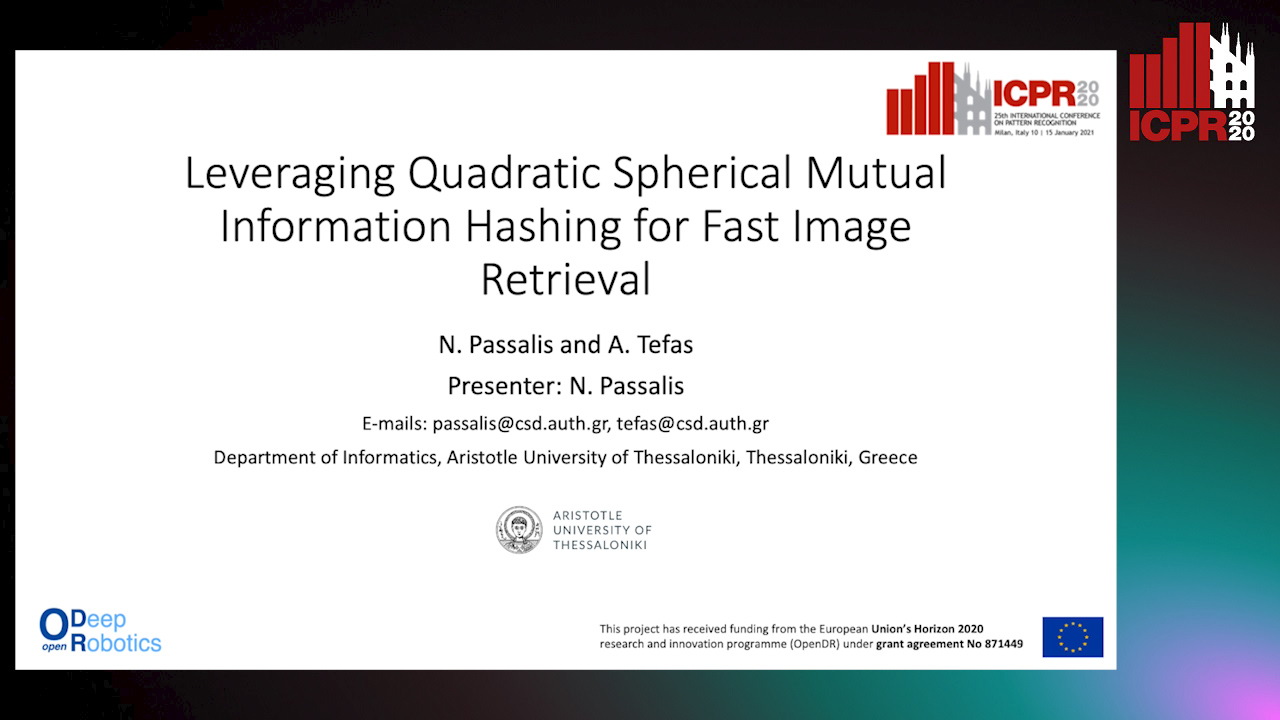
Auto-TLDR; Quadratic Mutual Information for Large-Scale Hashing and Information Retrieval
Abstract Slides Poster Similar
Label Self-Adaption Hashing for Image Retrieval
Jianglin Lu, Zhihui Lai, Hailing Wang, Jie Zhou

Auto-TLDR; Label Self-Adaption Hashing for Large-Scale Image Retrieval
Abstract Slides Poster Similar
VSR++: Improving Visual Semantic Reasoning for Fine-Grained Image-Text Matching
Hui Yuan, Yan Huang, Dongbo Zhang, Zerui Chen, Wenlong Cheng, Liang Wang
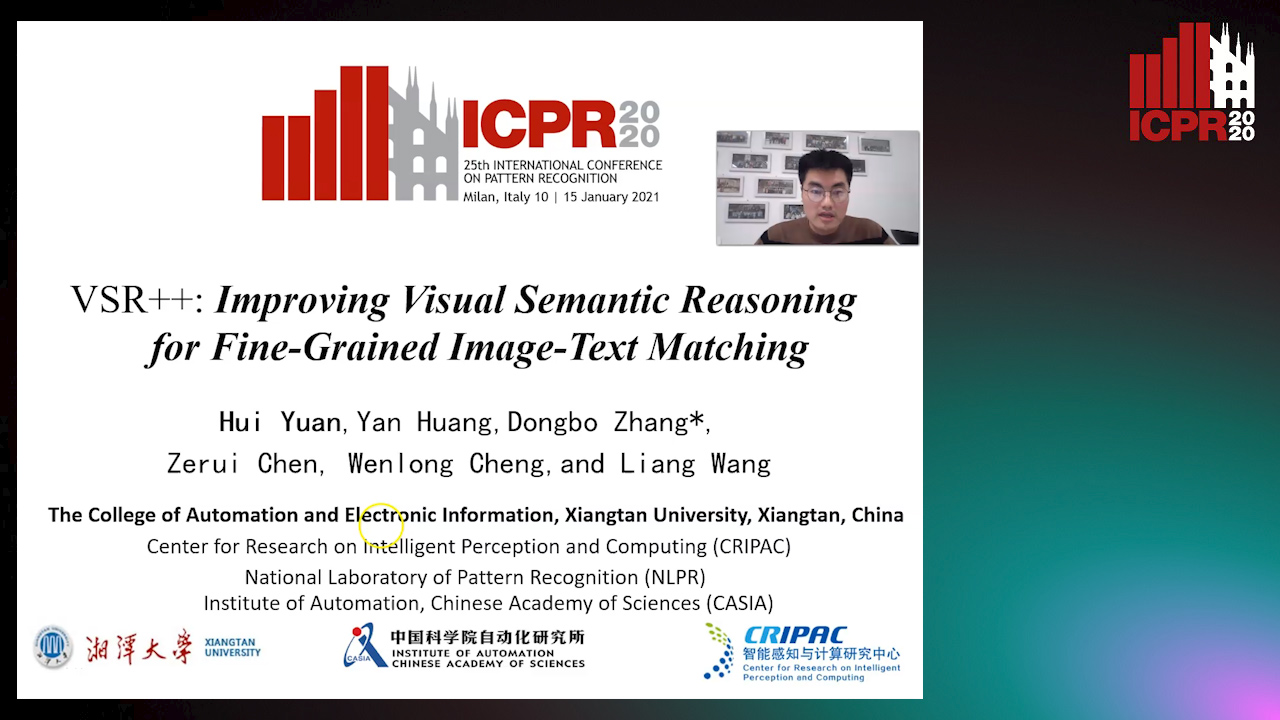
Auto-TLDR; Improving Visual Semantic Reasoning for Fine-Grained Image-Text Matching
Abstract Slides Poster Similar
A Novel Attention-Based Aggregation Function to Combine Vision and Language
Matteo Stefanini, Marcella Cornia, Lorenzo Baraldi, Rita Cucchiara

Auto-TLDR; Fully-Attentive Reduction for Vision and Language
Abstract Slides Poster Similar
Beyond the Deep Metric Learning: Enhance the Cross-Modal Matching with Adversarial Discriminative Domain Regularization
Li Ren, Kai Li, Liqiang Wang, Kien Hua
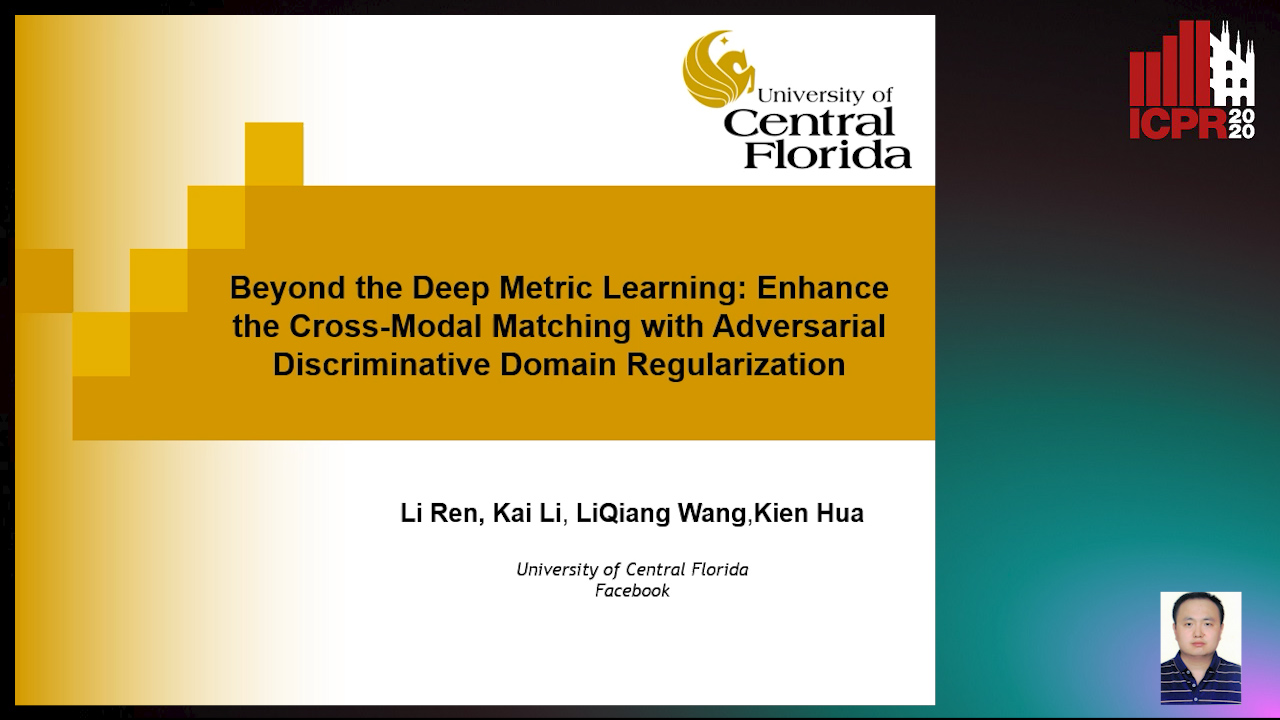
Auto-TLDR; Adversarial Discriminative Domain Regularization for Efficient Cross-Modal Matching
Abstract Slides Poster Similar
Cross-spectrum Face Recognition Using Subspace Projection Hashing
Hanrui Wang, Xingbo Dong, Jin Zhe, Jean-Luc Dugelay, Massimo Tistarelli

Auto-TLDR; Subspace Projection Hashing for Cross-Spectrum Face Recognition
Abstract Slides Poster Similar
Transformer Reasoning Network for Image-Text Matching and Retrieval
Nicola Messina, Fabrizio Falchi, Andrea Esuli, Giuseppe Amato

Auto-TLDR; A Transformer Encoder Reasoning Network for Image-Text Matching in Large-Scale Information Retrieval
Abstract Slides Poster Similar
Deep Composer: A Hash-Based Duplicative Neural Network for Generating Multi-Instrument Songs
Jacob Galajda, Brandon Royal, Kien Hua

Auto-TLDR; Deep Composer for Intelligence Duplication
MANet: Multimodal Attention Network Based Point-View Fusion for 3D Shape Recognition
Yaxin Zhao, Jichao Jiao, Ning Li

Auto-TLDR; Fusion Network for 3D Shape Recognition based on Multimodal Attention Mechanism
Abstract Slides Poster Similar
Webly Supervised Image-Text Embedding with Noisy Tag Refinement
Niluthpol Mithun, Ravdeep Pasricha, Evangelos Papalexakis, Amit Roy-Chowdhury
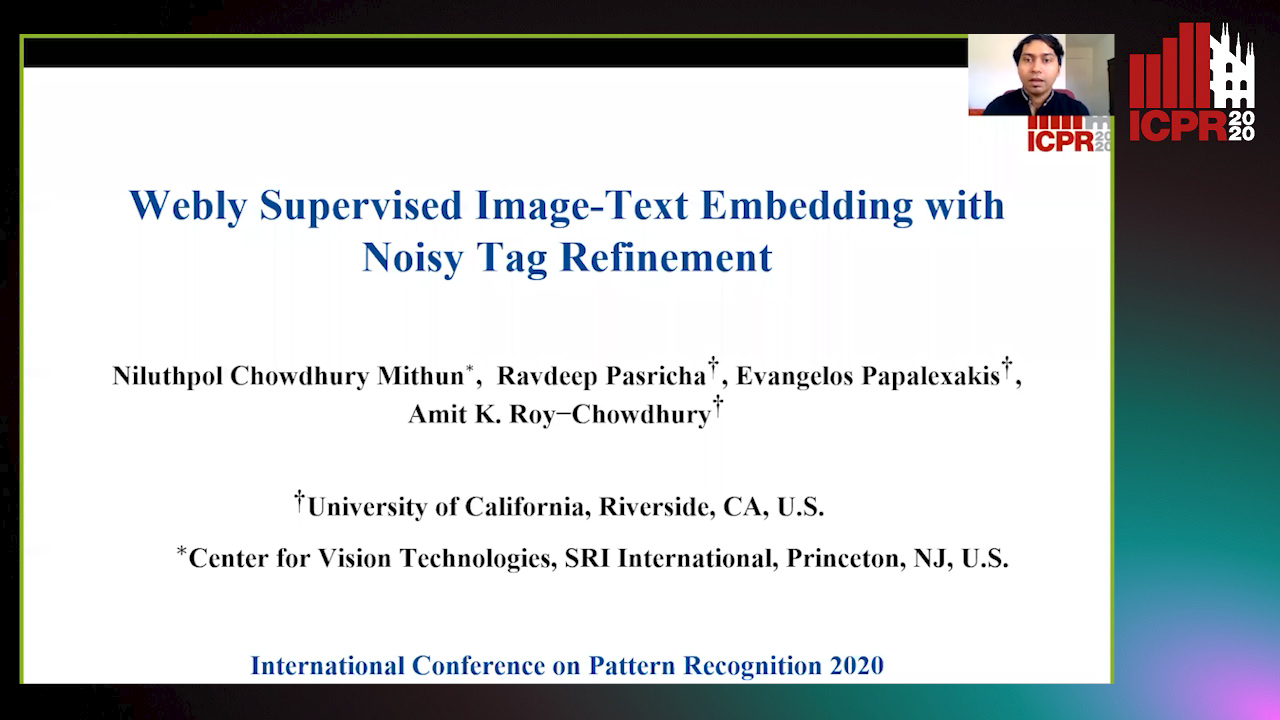
Auto-TLDR; Robust Joint Embedding for Image-Text Retrieval Using Web Images
Multi-Scale Cascading Network with Compact Feature Learning for RGB-Infrared Person Re-Identification
Can Zhang, Hong Liu, Wei Guo, Mang Ye

Auto-TLDR; Multi-Scale Part-Aware Cascading for RGB-Infrared Person Re-identification
Abstract Slides Poster Similar
Integrating Historical States and Co-Attention Mechanism for Visual Dialog
Tianling Jiang, Yi Ji, Chunping Liu

Auto-TLDR; Integrating Historical States and Co-attention for Visual Dialog
Abstract Slides Poster Similar
Zero-Shot Text Classification with Semantically Extended Graph Convolutional Network
Tengfei Liu, Yongli Hu, Junbin Gao, Yanfeng Sun, Baocai Yin

Auto-TLDR; Semantically Extended Graph Convolutional Network for Zero-shot Text Classification
Abstract Slides Poster Similar
Global Context-Based Network with Transformer for Image2latex
Nuo Pang, Chun Yang, Xiaobin Zhu, Jixuan Li, Xu-Cheng Yin

Auto-TLDR; Image2latex with Global Context block and Transformer
Abstract Slides Poster Similar
Aggregating Object Features Based on Attention Weights for Fine-Grained Image Retrieval
Hongli Lin, Yongqi Song, Zixuan Zeng, Weisheng Wang

Auto-TLDR; DSAW: Unsupervised Dual-selection for Fine-Grained Image Retrieval
RGB-Infrared Person Re-Identification Via Image Modality Conversion
Huangpeng Dai, Qing Xie, Yanchun Ma, Yongjian Liu, Shengwu Xiong

Auto-TLDR; CE2L: A Novel Network for Cross-Modality Re-identification with Feature Alignment
Abstract Slides Poster Similar
Exploiting Local Indexing and Deep Feature Confidence Scores for Fast Image-To-Video Search
Savas Ozkan, Gözde Bozdağı Akar
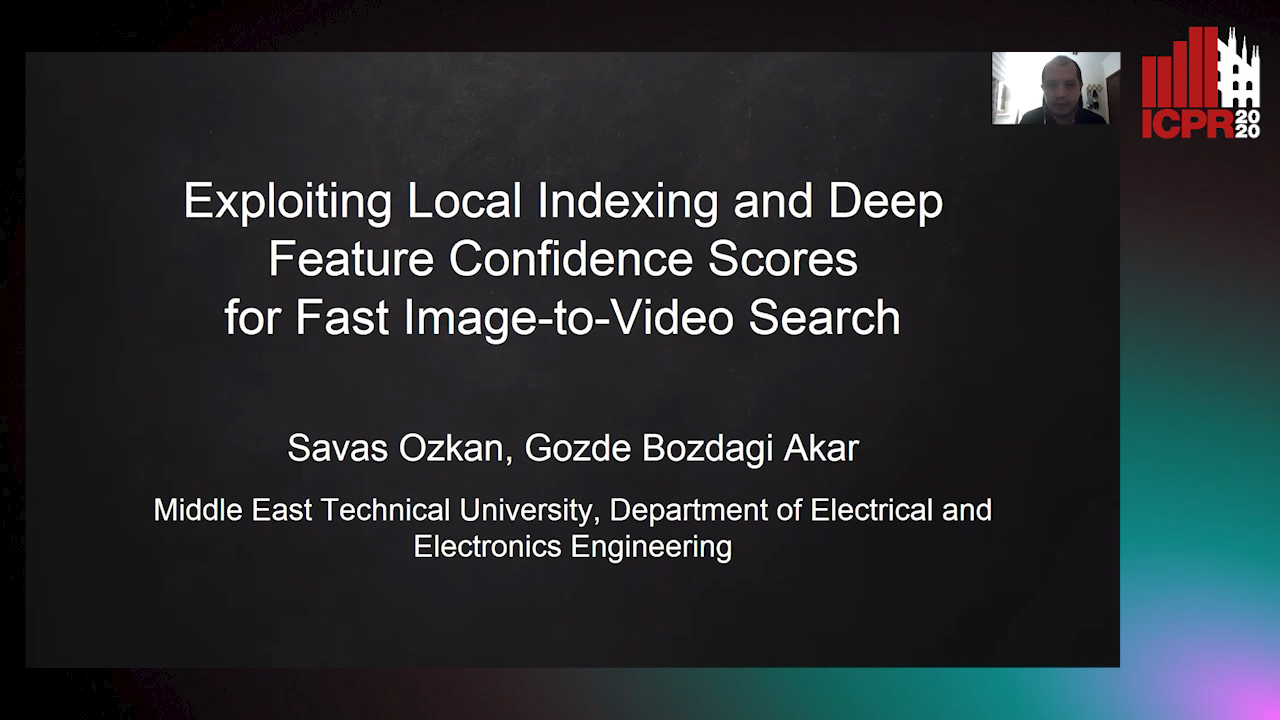
Auto-TLDR; Fast and Robust Image-to-Video Retrieval Using Local and Global Descriptors
Abstract Slides Poster Similar
JECL: Joint Embedding and Cluster Learning for Image-Text Pairs
Sean Yang, Kuan-Hao Huang, Bill Howe

Auto-TLDR; JECL: Clustering Image-Caption Pairs with Parallel Encoders and Regularized Clusters
Object Detection Using Dual Graph Network
Shengjia Chen, Zhixin Li, Feicheng Huang, Canlong Zhang, Huifang Ma

Auto-TLDR; A Graph Convolutional Network for Object Detection with Key Relation Information
Object Detection Model Based on Scene-Level Region Proposal Self-Attention
Yu Quan, Zhixin Li, Canlong Zhang, Huifang Ma

Auto-TLDR; Exploiting Semantic Informations for Object Detection
Abstract Slides Poster Similar
More Correlations Better Performance: Fully Associative Networks for Multi-Label Image Classification

Auto-TLDR; Fully Associative Network for Fully Exploiting Correlation Information in Multi-Label Classification
Abstract Slides Poster Similar
Edge-Aware Graph Attention Network for Ratio of Edge-User Estimation in Mobile Networks
Jiehui Deng, Sheng Wan, Xiang Wang, Enmei Tu, Xiaolin Huang, Jie Yang, Chen Gong

Auto-TLDR; EAGAT: Edge-Aware Graph Attention Network for Automatic REU Estimation in Mobile Networks
Abstract Slides Poster Similar
Rethinking ReID:Multi-Feature Fusion Person Re-Identification Based on Orientation Constraints
Mingjing Ai, Guozhi Shan, Bo Liu, Tianyang Liu

Auto-TLDR; Person Re-identification with Orientation Constrained Network
Abstract Slides Poster Similar
Supporting Skin Lesion Diagnosis with Content-Based Image Retrieval
Stefano Allegretti, Federico Bolelli, Federico Pollastri, Sabrina Longhitano, Giovanni Pellacani, Costantino Grana

Auto-TLDR; Skin Images Retrieval Using Convolutional Neural Networks for Skin Lesion Classification and Segmentation
Abstract Slides Poster Similar
Decoupled Self-Attention Module for Person Re-Identification
Chao Zhao, Zhenyu Zhang, Jian Yang, Yan Yan

Auto-TLDR; Decoupled Self-attention Module for Person Re-identification
Abstract Slides Poster Similar
A Base-Derivative Framework for Cross-Modality RGB-Infrared Person Re-Identification
Hong Liu, Ziling Miao, Bing Yang, Runwei Ding

Auto-TLDR; Cross-modality RGB-Infrared Person Re-identification with Auxiliary Modalities
Abstract Slides Poster Similar
Reinforcement Learning with Dual Attention Guided Graph Convolution for Relation Extraction
Zhixin Li, Yaru Sun, Suqin Tang, Canlong Zhang, Huifang Ma

Auto-TLDR; Dual Attention Graph Convolutional Network for Relation Extraction
Abstract Slides Poster Similar
Adaptive Image Compression Using GAN Based Semantic-Perceptual Residual Compensation
Ruojing Wang, Zitang Sun, Sei-Ichiro Kamata, Weili Chen

Auto-TLDR; Adaptive Image Compression using GAN based Semantic-Perceptual Residual Compensation
Abstract Slides Poster Similar
Picture-To-Amount (PITA): Predicting Relative Ingredient Amounts from Food Images
Jiatong Li, Fangda Han, Ricardo Guerrero, Vladimir Pavlovic
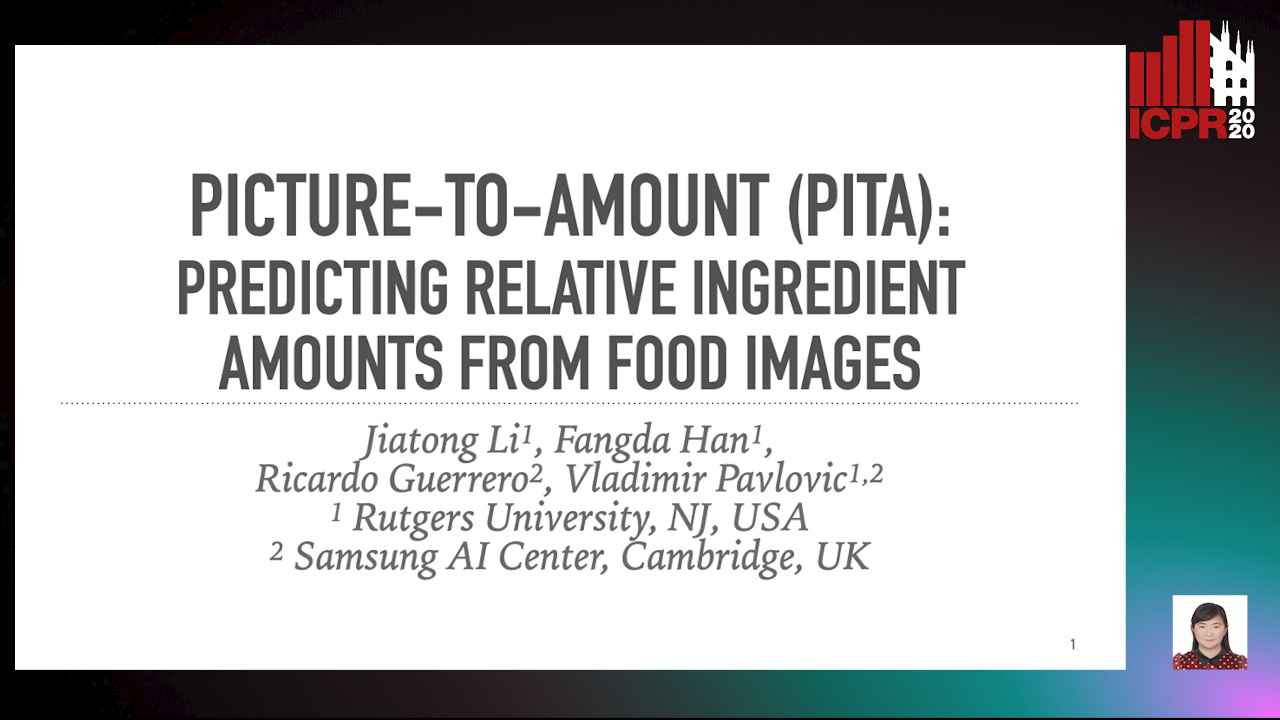
Auto-TLDR; PITA: A Deep Learning Architecture for Predicting the Relative Amount of Ingredients from Food Images
Abstract Slides Poster Similar
Attentive Part-Aware Networks for Partial Person Re-Identification
Lijuan Huo, Chunfeng Song, Zhengyi Liu, Zhaoxiang Zhang

Auto-TLDR; Part-Aware Learning for Partial Person Re-identification
Abstract Slides Poster Similar
Multi-Modal Contextual Graph Neural Network for Text Visual Question Answering
Yaoyuan Liang, Xin Wang, Xuguang Duan, Wenwu Zhu

Auto-TLDR; Multi-modal Contextual Graph Neural Network for Text Visual Question Answering
Abstract Slides Poster Similar
Attention-Based Deep Metric Learning for Near-Duplicate Video Retrieval
Kuan-Hsun Wang, Chia Chun Cheng, Yi-Ling Chen, Yale Song, Shang-Hong Lai

Auto-TLDR; Attention-based Deep Metric Learning for Near-duplicate Video Retrieval
Context Visual Information-Based Deliberation Network for Video Captioning
Min Lu, Xueyong Li, Caihua Liu

Auto-TLDR; Context visual information-based deliberation network for video captioning
Abstract Slides Poster Similar
Attentive Visual Semantic Specialized Network for Video Captioning
Jesus Perez-Martin, Benjamin Bustos, Jorge Pérez

Auto-TLDR; Adaptive Visual Semantic Specialized Network for Video Captioning
Abstract Slides Poster Similar
Sketch-SNet: Deeper Subdivision of Temporal Cues for Sketch Recognition
Yizhou Tan, Lan Yang, Honggang Zhang
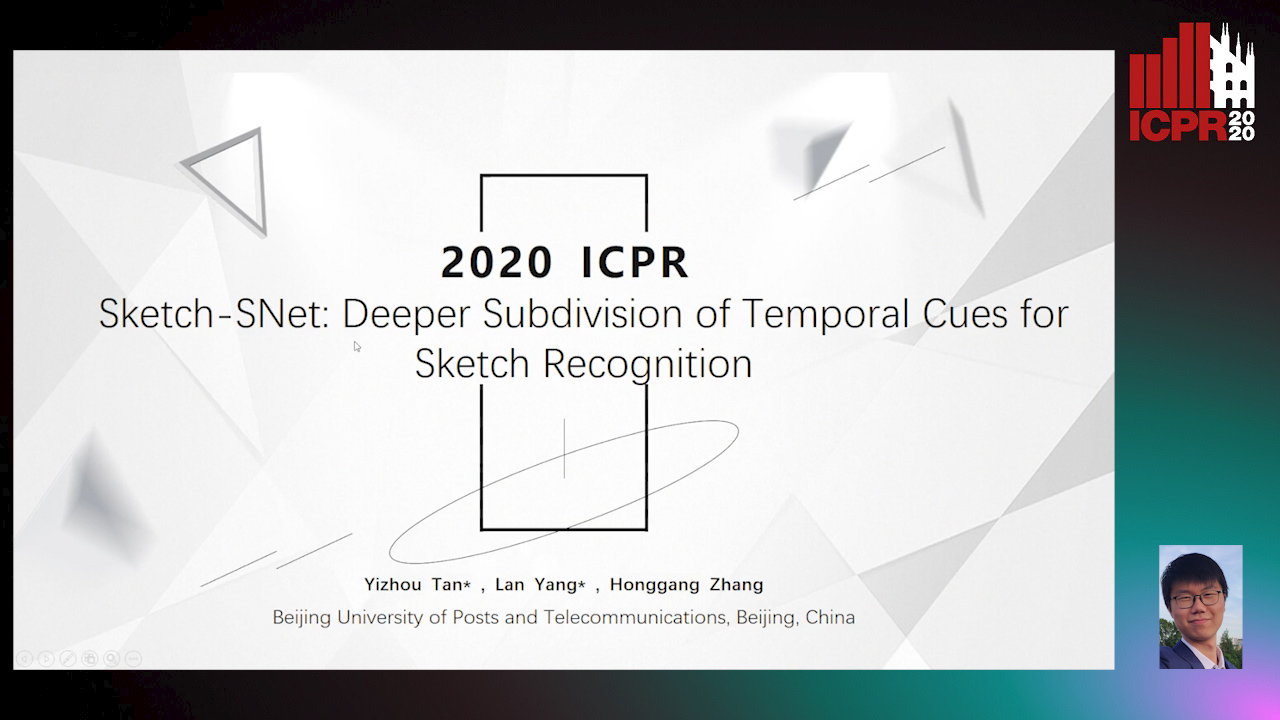
Auto-TLDR; Sketch Recognition using Invariable Structural Feature and Drawing Habits Feature
Abstract Slides Poster Similar
Cross-Lingual Text Image Recognition Via Multi-Task Sequence to Sequence Learning
Zhuo Chen, Fei Yin, Xu-Yao Zhang, Qing Yang, Cheng-Lin Liu

Auto-TLDR; Cross-Lingual Text Image Recognition with Multi-task Learning
Abstract Slides Poster Similar
A CNN-RNN Framework for Image Annotation from Visual Cues and Social Network Metadata
Tobia Tesan, Pasquale Coscia, Lamberto Ballan

Auto-TLDR; Context-Based Image Annotation with Multiple Semantic Embeddings and Recurrent Neural Networks
Abstract Slides Poster Similar
TAAN: Task-Aware Attention Network for Few-Shot Classification

Auto-TLDR; TAAN: Task-Aware Attention Network for Few-Shot Classification
Abstract Slides Poster Similar
SL-DML: Signal Level Deep Metric Learning for Multimodal One-Shot Action Recognition
Raphael Memmesheimer, Nick Theisen, Dietrich Paulus

Auto-TLDR; One-Shot Action Recognition using Metric Learning
Price Suggestion for Online Second-Hand Items
Liang Han, Zhaozheng Yin, Zhurong Xia, Li Guo, Mingqian Tang, Rong Jin
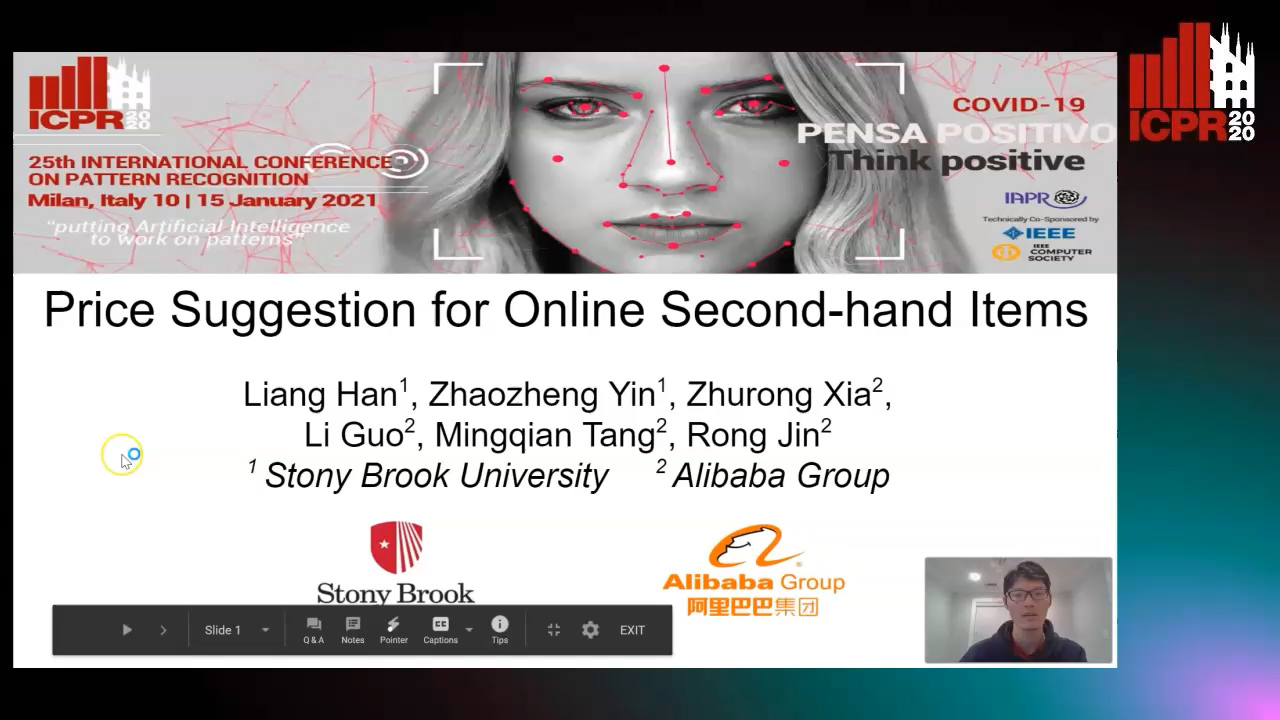
Auto-TLDR; An Intelligent Price Suggestion System for Online Second-hand Items
Abstract Slides Poster Similar
RWMF: A Real-World Multimodal Foodlog Database
Pengfei Zhou, Cong Bai, Kaining Ying, Jie Xia, Lixin Huang
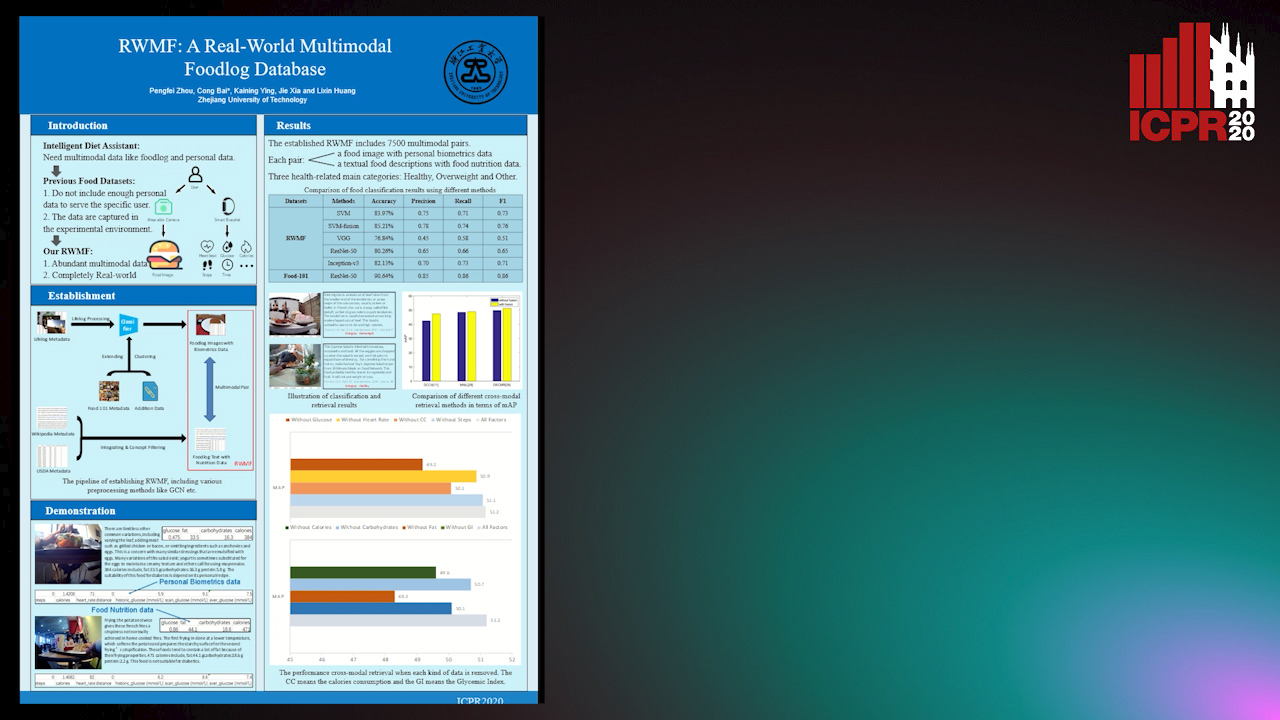
Auto-TLDR; Real-World Multimodal Foodlog: A Real-World Foodlog Database for Diet Assistant
Abstract Slides Poster Similar